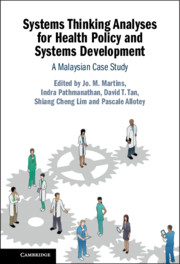Boxes
2.2Systems thinking principles for health system improvement
4.1Excerpts from the Declaration of the Alma Ata International Conference on Primary Health Care, September 1978
4.3The role of NGOs in a health system dominated by the public sector
4.4Influence of other health system components on PHC: summary of illustrative examples
4.8System observations: when systems outcomes diverge from stated goals
4-AReviewed approach of PHC: wellness, illness, support services and emergency information (REAP-WISE)
5.1Why were hospitals concentrated in the West Coast states during colonial days?
5.4System observations: shifting the healthcare burden to the private sector
5.5Key features of the QAP for secondary and tertiary healthcare services in the public sector
6.1The major communicable diseases of concern in Malaysia (1960s to mid-1980s)
6.2The role of the IMR in vaccine production and diagnostic services
6.3System observations: understanding feedback loops through communicable diseases
6.5Examples of integration of disease prevention and control activities (prevention, early detection, management and treatment) in PHC clinics
6.6Key milestones in the evolution of responses to emerging communicable diseases
6.7System observations: considering feedback loops in behavioural change
6-BKey involvement by the MAC in the government’s adoption of harm reduction strategies
7-BLeadership and commitment of state public health engineers
8.1Key features of the rapid production of allied health personnel
8.3Examples of key initiatives to upgrade health staff competencies during the 1980s and 1990s
8.4Malaysian experiences on moving basic training of health personnel from the health to the education sector
8.7Governance structures (legislation, boards, registration and annual licensing) to ensure quality and safety of practice of healthcare professionals
9.3Pre-payment and fund pooling features in health financing sources
9.5Systems observations: interactions between modes of health financing and delivery
10.1Health systems research provided information for managerial decision-making
10.2System observations: closing the feedback loop to improve data collection
10.3System observations: use of health information for single- and double-loop learning
11.1Legislation to safeguard the people vis-à-vis medical products
11.2Management of the flow of medicines in the MoH system to ensure uninterrupted supply at the front line
11.3Landmarks in developing institutional capacity for oversight of pharmacy and pharmaceutical trade
11.4System observations: path dependency in dispensing practices
11.5System observations: the need for an equitable international system for drug development and public good
11-AUsage and popularity of traditional and complementary medicines (T&CM)
12.3System observations: systems perspectives on leadership development
12-AEssential vocabulary regarding rules governing international trade of medicines



